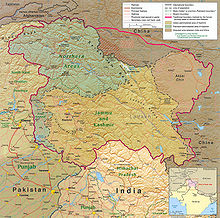| State of Jammu and Kashmir | |||||||||||
|---|---|---|---|---|---|---|---|---|---|---|---|
| Region formerly administered by India as a state | |||||||||||
| 1952–2019 | |||||||||||
 Map of Jammu and Kashmir | |||||||||||
| Capital | Srinagar (May–October) Jammu (November–April)[1][clarification needed] | ||||||||||
| Area | |||||||||||
| • Coordinates | 34°00′N 76°30′E / 34.0°N 76.5°E | ||||||||||
| Government | |||||||||||
| Governor | |||||||||||
• 1952–1965 as Sadr-e-Riyasat; 1965–1967 | Karan Singh (first) | ||||||||||
• 2018–2019[2] | Satya Pal Malik (last) | ||||||||||
| Chief Minister | |||||||||||
• 1952–1953 as Prime Minister | Sheikh Abdullah (first) | ||||||||||
• 2016–2018[3] | Mehbooba Mufti (last) | ||||||||||
| Legislature | Jammu and Kashmir Legislature | ||||||||||
• Upper house | Jammu and Kashmir Legislative Council (36 seats) | ||||||||||
• Lower house | Jammu and Kashmir Legislative Assembly (89 seats) | ||||||||||
| History | |||||||||||
• Abolition of monarchy | 17 November 1952 | ||||||||||
| 14 May 1954 | |||||||||||
| 31 October 2019 | |||||||||||
| Political subdivisions | 22 districts | ||||||||||
| |||||||||||
Jammu[a] and Kashmir[b] was a region formerly administered by India as a state from 1952 to 2019, constituting the southern and southeastern portion of the larger Kashmir region, which has been the subject of a dispute between India, Pakistan and China since the mid-20th century.[5][6] The underlying region of this state were parts of the former princely state of Jammu and Kashmir, whose western districts, now known as Azad Kashmir, and northern territories, now known as Gilgit-Baltistan, are administered by Pakistan. The Aksai Chin region in the east, bordering Tibet, has been under Chinese control since 1962.
After the Government of India repealed the special status accorded to Jammu and Kashmir under Article 370 of the Indian constitution in 2019, the Parliament of India passed the Jammu and Kashmir Reorganisation Act, which contained provisions that dissolved the state and reorganised it into two union territories – Jammu and Kashmir in the west and Ladakh in the east, with effect from 31 October 2019.[7] At the time of its dissolution, Jammu and Kashmir was the only state in India with a Muslim-majority population.
- ^ The Hindu Net Desk (8 May 2017). "What is the Darbar Move in J&K all about?". The Hindu. Archived from the original on 10 November 2017. Retrieved 23 February 2019.
- ^ "Satya Pal Malik sworn in as Jammu and Kashmir governor". The Economic Times. Press Trust of India. 23 August 2018. Archived from the original on 23 August 2018. Retrieved 31 August 2018.
- ^ "BJP-PDP alliance ends in Jammu and Kashmir LIVE updates: Mehbooba Mufti resigns as chief minister; Governor's Rule in state". Firstpost. 19 June 2018. Retrieved 19 June 2018.
- ^ a b Jones, Daniel (2003) [1917], Peter Roach; James Hartmann; Jane Setter (eds.), English Pronouncing Dictionary, Cambridge: Cambridge University Press, ISBN 978-3-12-539683-8
- ^ Akhtar, Rais; Kirk, William, Jammu and Kashmir, State, India, Encyclopaedia Britannica, retrieved 7 August 2019 (subscription required) Quote: "Jammu and Kashmir, state of India, located in the northern part of the Indian subcontinent in the vicinity of the Karakoram and westernmost Himalayan mountain ranges. The state is part of the larger region of Kashmir, which has been the subject of dispute between India, Pakistan, and China since the partition of the subcontinent in 1947."
- ^ Osmańczyk, Edmund Jan (2003), Encyclopedia of the United Nations and International Agreements: G to M, Taylor & Francis, pp. 1191–, ISBN 978-0-415-93922-5 Quote: "Jammu and Kashmir: Territory in northwestern India, subject to a dispute between India and Pakistan. It has borders with Pakistan and China."
- ^ "Jammu Kashmir Article 370: Govt revokes Article 370 from Jammu and Kashmir, bifurcates state into two Union Territories". The Times of India. PTI. 5 August 2019. Archived from the original on 5 August 2019. Retrieved 5 August 2019.
Cite error: There are <ref group=lower-alpha> tags or {{efn}} templates on this page, but the references will not show without a {{reflist|group=lower-alpha}} template or {{notelist}} template (see the help page).

